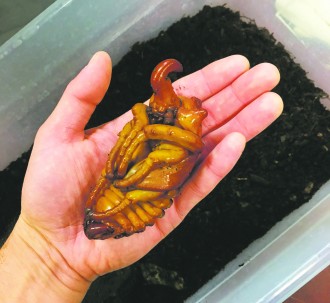BUGarium
BUGarium
July 7, 2023By GWYNNE ANN UNRUH

I grew up on the East Coast in a stone colonial house built in the late 1700s in the middle of the woods near a small stream. The perfect habitat for a variety of bugs. My parents called the ones that were common in our home “thousand leggers” (centipedes) and “daddy longlegs” (arachnids that look like spiders with very long legs). The comical names helped me overcome a myriad of childhood fears about those bugs. Moving to New Mexico and a drier climate, I naively thought that I wouldn’t encounter as many bugs as I had back East. Was I wrong!
The thousand leggers here are massive, and the daddy longlegs seem stunted next to tarantulas and the huge tarantula wasps that kill them. The scorpions are dangerous, and then there are the comical dug beetles that roll up “nutritious balls of excrement” up to 50 times heavier than their own bodies to feed their young. Raising my children among these scary creatures and helping them overcome their fears was a challenge; I had to conquer my own fears as well. I wish the BUGarium at ABQ BioPark Botanic Garden existed back then. My job would have been easier.
Fear of bugs, insects and creepy crawlies is completely normal. Taking that fear to the extreme is not. A child refusing to go into their bedroom because there was once a spider there needs patience, support and an understanding of the bug world. Try to help them look at bugs with a sense of appreciation and wonder; it can help overcome their, and perhaps your, fears.
Talk to them when bugs aren’t around about how we can’t live without them. They pollinate our crops, disperse seeds and help maintain ecosystems and wildlife. Most aren’t dangerous and are more afraid of us than we are of them. Next, visit the BUGarium for a safe place to help kids get up close and personal with creepy crawlies.
The BUGarium houses an impressive collection of creatures of the many-legged variety with antennae, mandibles and exoskeletons to protect them from humans. The immersive public exhibit features naturalistic habitats designed to reveal the unseen wonders of these bugs from around the world. You’ll see goliath beetles, stick insects, Tanzanian pink-legged millipedes and more. They also have naked mole rats, scorpions and tarantulas.
One of the goals of the BUGarium is to expose people to the amazing world of arthropods (bugs) and correct misconceptions through education. Eight of 10 animals on Earth are arthropods, and we can’t live without them because they pollinate flowers, feed other animals, eat dead things and play other important roles.
I recently spoke with Jason C. Schaller, the resident entomologist in charge of the BUGarium. He specializes in studying insects and was hired as the curator of entomology for the BUGarium in 2016, when it was a new exhibit.
“It had just opened up to the public, and I did the fine tuning of the exhibit and continue to do that to this day. It’s a never-ending process with a large exhibit of the scope the BUGarium is,” Schaller said.
Schaller has been into bugs and nature as far back as he can remember. “I took after my dad; we've been collecting bugs together since I was 3 years old,” he said, adding that his mother wasn't ever really interested in them, but was always a good sport. “She was always happy to humor me and my dad. She put up with a lot,” he said.
Behind the scenes is the Arthropod Rearing Lab, a one-of-a-kind nursery that ensures a constant and healthy supply of exotic creatures like spiders, beetles and butterflies for the BioPark. You can schedule an hourlong tour of the breeding facility to get up close and touch, feel and hold some of these bugs. The lab must produce thousands of fresh specimens for the public exhibits as most insects don’t live for more than a few days or months. Scientists at the lab also study the various habits of the different species and track physical development, diet, life cycle, environmental conditions and mating and other social traits.
The lab is kept at a humid 78 degrees, and wall-to-wall plexiglass and mesh cages house up to 100 species of arthropods. The Rearing Lab follows strict rules to prevent the critters from escaping from the lab or sneaking in from the outside. Visitors can’t carry bags or anything that insects might decide to crawl into.
A strong sense of curiosity and comfort being around bugs, especially big ones, is needed to enjoy the behind-the-scenes tour. Some of the cages will be opened and Schaller will bring out a sample bug and invite you to hold it, while assuring you it won’t bite, sting, poop on you or endanger your life. You’ll have the opportunity to feed a tarantula and to hold a millipede, a massive beetle, a cockroach or a scorpion in your palms.
Curious, I asked Schaller exactly what a naked mole rat is. “A naked mole rat is a very bizarre rodent species, one of the weirdest mammals on Earth,” he said. “They're completely hairless, except for some sensory hairs. And they are one of the only mammals that have a huge social structure where there's a queen and a worker cast. You can see all their activity going on and they are blind, so they can't really tell that we're all watching them.”
Well, there you have it. Bugs, scorpions, tarantulas and mole rats galore are waiting to greet you at the ABQ BioPark BUGarium. It’s a unique experience that will help your child and perhaps, yourself, overcome any fears about bugs.
The BUGarium is open from 9 a.m. to 4:30 p.m. with Botanic Garden admission. Arthropod Rearing Lab tours are available by request Saturday through Thursday. Tours start at 2:30 p.m. and cost $40 per guest with a limit of 10 people per tour. Book tours two weeks in advance: info@bioparksociety.org or 505-764-6280.




